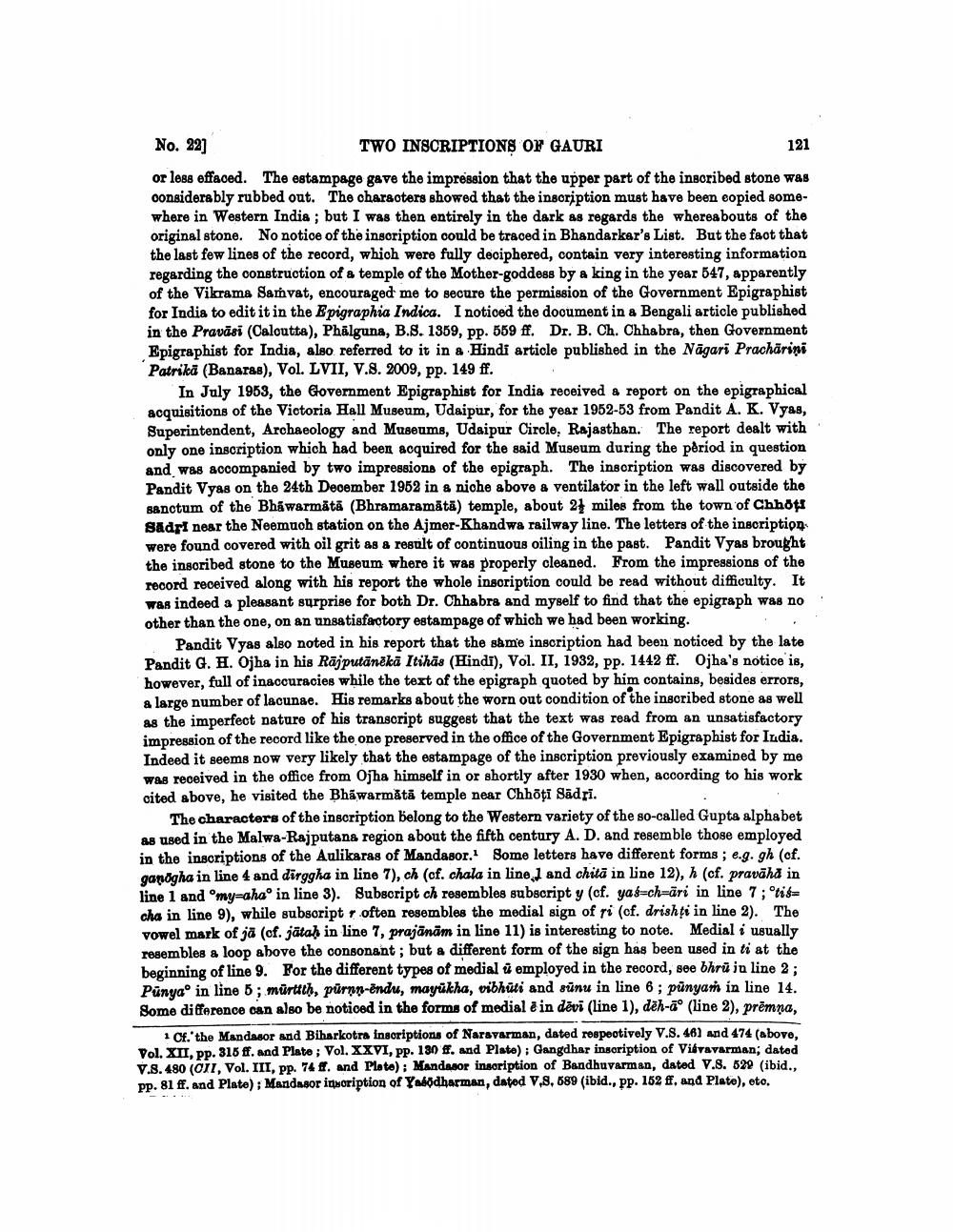________________
No. 22]
TWO INSCRIPTIONS OF GAURI
121
or less effaced. The estampage gave the impression that the upper part of the inscribed stone was considerably rubbed out. The characters showed that the inscription must have been copied somewhere in Western India; but I was then entirely in the dark as regards the whereabouts of the original stone. No notice of the inscription could be traced in Bhandarkar's List. But the fact that the last few lines of the record, which were fully deciphered, contain very interesting information regarding the construction of a temple of the Mother-goddess by a king in the year 547, apparently of the Vikrama Samvat, encouraged me to secure the permission of the Government Epigraphist for India to edit it in the Epigraphia Indica. I noticed the document in a Bengali article published in the Pravasi (Calcutta), Phalguna, B.S. 1359, pp. 559 ff. Dr. B. Ch. Chhabra, then Government Epigraphist for India, also referred to it in a Hindi article published in the Nagari Prachāriņi Patrika (Banaras), Vol. LVII, V.S. 2009, pp. 149 ff.
In July 1953, the Government Epigraphist for India received a report on the epigraphical acquisitions of the Victoria Hall Museum, Udaipur, for the year 1952-53 from Pandit A. K. Vyas, Superintendent, Archaeology and Museums, Udaipur Circle, Rajasthan. The report dealt with only one inscription which had been acquired for the said Museum during the period in question and was accompanied by two impressions of the epigraph. The inscription was discovered by Pandit Vyas on the 24th December 1952 in a niche above a ventilator in the left wall outside the sanctum of the Bhawarmata (Bhramaramätä) temple, about 2 miles from the town of Chhoti Sadri near the Neemuch station on the Ajmer-Khandwa railway line. The letters of the inscription were found covered with oil grit as a result of continuous oiling in the past. Pandit Vyas brought the inscribed stone to the Museum where it was properly cleaned. From the impressions of the record received along with his report the whole inscription could be read without difficulty. It was indeed a pleasant surprise for both Dr. Chhabra and myself to find that the epigraph was no other than the one, on an unsatisfactory estampage of which we had been working.
Pandit Vyas also noted in his report that the same inscription had been noticed by the late Pandit G. H. Ojha in his Rajputänekä Itihas (Hindi), Vol. II, 1932, pp. 1442 ff. Ojha's notice is, however, full of inaccuracies while the text of the epigraph quoted by him contains, besides errors, a large number of lacunae. His remarks about the worn out condition of the inscribed stone as well as the imperfect nature of his transcript suggest that the text was read from an unsatisfactory impression of the record like the one preserved in the office of the Government Epigraphist for India. Indeed it seems now very likely that the estampage of the inscription previously examined by me was received in the office from Ojha himself in or shortly after 1930 when, according to his work cited above, he visited the Bhawarmată temple near Chhōţi Sādri.
The characters of the inscription belong to the Western variety of the so-called Gupta alphabet as used in the Malwa-Rajputana region about the fifth century A. D. and resemble those employed in the inscriptions of the Aulikaras of Mandasor. Some letters have different forms; e.g. gh (cf. ganogha in line 4 and dirggha in line 7), ch (cf. chala in line, and chita in line 12), h (cf. pravähä in line 1 and "my-aha in line 3). Subscript ch resembles subscript y (cf. yas-ch-ari in line 7; °tis= cha in line 9), while subscript r often resembles the medial sign of ri (cf. drishti in line 2). The vowel mark of ja (cf. jätaḥ in line 7, prajānām in line 11) is interesting to note. Medial i usually resembles a loop above the consonant; but a different form of the sign has been used in ti at the beginning of line 9. For the different types of medial & employed in the record, see bhru in line 2; Punya in line 5; mürtttḥ, pürnn-endu, mayükha, vibhuti and sunu in line 6; punyam in line 14. Some difference can also be noticed in the forms of medial è in devi (line 1), deh-a° (line 2), prēmņa,
1 Cf. the Mandasor and Biharkotra inscriptions of Naravarman, dated respectively V.S. 461 and 474 (above, Vol. XII, pp. 315 ff. and Plate; Vol. XXVI, pp. 130 ff. and Plate); Gangdhar inscription of Viévavarman; dated V.S. 480 (CII, Vol. III, pp. 74 ff. and Plate): Mandasor inscription of Bandhuvarman, dated V.S. 529 (ibid., pp. 81 ff. and Plate); Mandasor inscription of Yasodharman, dated V,S, 589 (ibid., pp. 152 ff, and Plate), etc.




